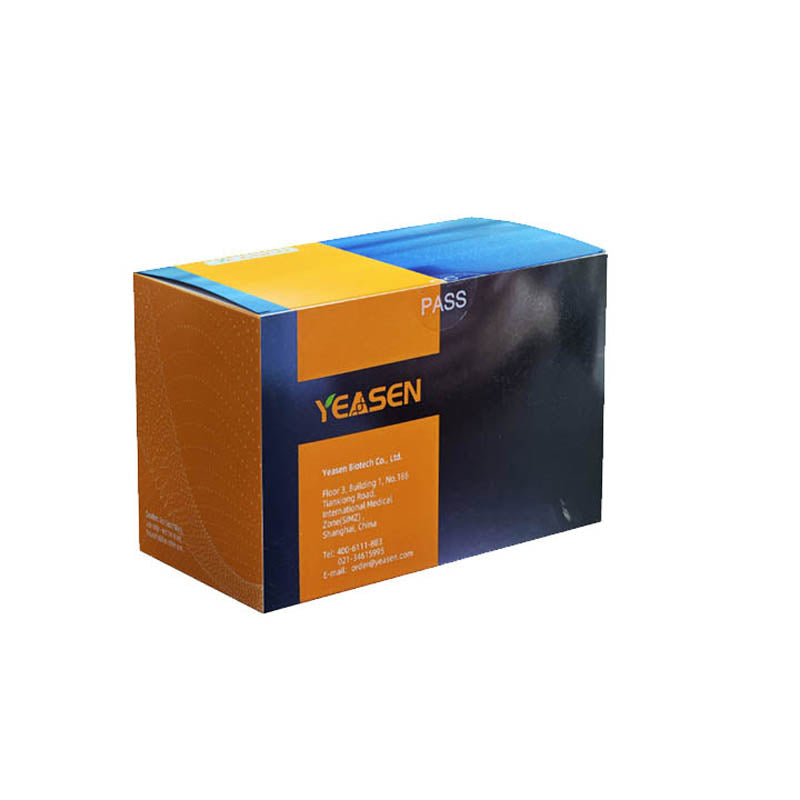Description
Nanobody-Tn5 is a recombinant Tn5 transposase fused with nanobody which can specific bind with primary antibodies from two different species (mouse and rabbit).
Product Information
|
Catalog No. |
12595ES01/12595ES02/12595ES03 |
|
specifications |
10 μL/ 80 μL/ 100 μL |
Product Components
|
Component No. |
Component name |
12595ES01 |
12595ES02 |
12595ES03 |
|
12595-A |
Anti-mouse Tn5 |
10 μL |
80 μL |
100 μL |
|
12595-B |
Anti-rabbit Tn5 |
10 μL |
80 μL |
100 μL |
|
12595-C |
Assemble buffer |
10 μL |
80 μL |
100 μL |
Shipping and Storage
Stored at -85° ~ -65℃ for one year.
Figures
H3K4me1:

H3K4me3

H3K9me3

H3K27ac

H3K27me3
H3K27me3

Control: Conventional pA/G-Tn5, Cut&Tag Multi Cut&Tag: Nanobody Tn5
Instruction
Take high-throughput sequencing library preparation as an example, be sure to read the instructions carefully before use.
1. Adapter preparation
1) Reference oligo name and sequence of Illumina platform:
Oligo A-1:5'-AATGATACGGCGACCACCGAGATCTACACATAAGGCTCGTCGGCAGCGTCAGATGTGTATAAGAGACAG-3'
Oligo A-2:5'-AATGATACGGCGACCACCGAGATCTACACATATCCTTCGTCGGCAGCGTCAGATGTGTATAAGAGACAG-3'
Oligo A-3:5'-TCGTCGGCAGCGTCAGATGTGTATAAGAGACAG-3′
Oligo B:5'-GTCTCGTGGGCTCGGAGATGTGTATAAGAGACAG-3′
Oligo C:5'-phos-CTGTCTCTTATACACATCT-3'
2) Dissolve the Oligo A, Oligo B, and Oligo C to 200 μM.
3) The following reaction systems are formulated respectively:
|
component |
Reaction 1 |
|
Oligo B (200 μM) |
10 μL |
|
Oligo C (200 μM) |
10 μL |
|
total |
20 μL |
|
component |
Reaction 2 |
|
Oligo A-1 or A-2 or A-3(200 μM) |
10 μL |
|
Oligo C (200 μM) |
10 μL |
|
total |
20 μL |
4) Mix reaction 1 and 2 together, and briefly centrifuge to bring the solution back to the bottom of the tube. Place in the PCR instrument, set up the following program and run it: hot lid at 105°C,and then heat at 94℃ for 2 min. After the time was up, the reaction procedure was stopped without opening the hot lid.The PCR tube was naturally cooled in the PCR instrument for 2 h, and then placed at 4℃ for 5 min.
5) After the reaction, mix the equal volumes of Reaction 1 and Reaction 2. Named ad Adapter Mix and stored from – 25 to – 15℃.
2. for transposon generation
1) To configure the following reaction system:
|
component |
volume (μL) |
|
Anti-mouse Tn5 or Anti-rabbit Tn5 |
10 |
|
Adapter mix (50 μM) |
0.5 |
|
Assemble Buffer |
0.5 |
2) Reaction conditions: use the pipette to gently blow and mix well. Perform the reaction at 25℃ for 1 h (hot lid off). The products of reaction can be directly applied to the library preparation or stored from -25 to -15℃.
Notes
1. Transposase is temperature-sensitive, so it is recommended to complete the adapter embedding as soon as possible. The generated transposon can be stored at-25~ -15℃, with a validity period of 1 year.
2. This product is used for scientific research purposes only.
3. For your safety and health, please wear laboratory clothes and wear disposable gloves.
Payment & Security
Your payment information is processed securely. We do not store credit card details nor have access to your credit card information.
Inquiry
You may also like
FAQ
The product is for research purposes only and is not intended for therapeutic or diagnostic use in humans or animals. Products and content are protected by patents, trademarks, and copyrights owned by Yeasen Biotechnology. Trademark symbols indicate the country of origin, not necessarily registration in all regions.
Certain applications may require additional third-party intellectual property rights.
Yeasen is dedicated to ethical science, believing our research should address critical questions while ensuring safety and ethical standards.

